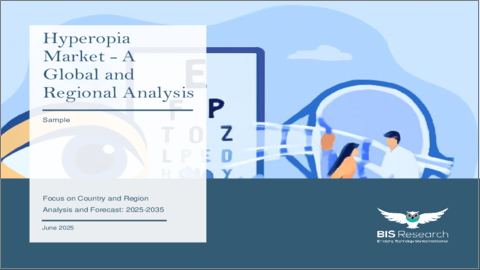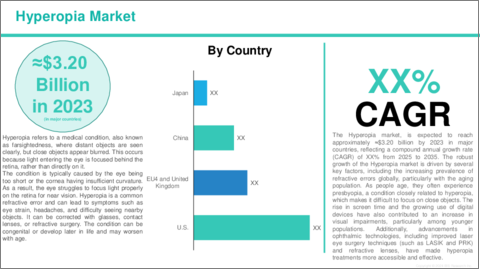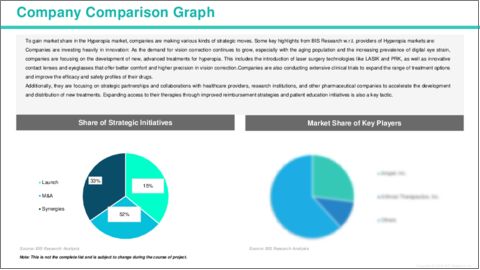|
|
市場調査レポート
商品コード
1759270
遠視市場 - 世界および地域別分析:国別・地域別 - 分析と予測(2025年~2035年)Hyperopia Market - A Global and Regional Analysis: Focus on Country and Region - Analysis and Forecast, 2025-2035 |
||||||
カスタマイズ可能
|
|||||||
| 遠視市場 - 世界および地域別分析:国別・地域別 - 分析と予測(2025年~2035年) |
|
出版日: 2025年06月30日
発行: BIS Research
ページ情報: 英文 100 Pages
納期: 1~5営業日
|
全表示
- 概要
- 図表
- 目次
遠視は目の屈折異常で、一般に遠視として知られています。
眼球に入る光が網膜に直接焦点を結ぶのではなく、網膜の後方に焦点を結ぶため、近くのものはぼやけて見え、遠くのものは、はっきり見えます。遠視は多くの場合、眼球が短すぎるか、角膜の曲率が不十分なために起こります。生まれつきの場合もあり、その程度はさまざまです。遠視の症状には、読書困難、眼精疲労、頭痛、近くを見るときのかすみなどがあります。遠視は通常、眼鏡、コンタクトレンズ、またはレーシックのような屈折矯正手術によって矯正されます。
遠視市場の主な促進要因の一つは、人口の高齢化です。加齢に伴い、近くのものに焦点を合わせる目の自然な能力は低下し、老眼として知られる状態になりますが、これは遠視と密接な関係があります。世界人口の高齢化に伴い、遠視や老眼の発生率が増加しており、視力矯正ソリューションの需要が高まっています。さらに、スマートフォン、コンピューター、タブレットなどのデジタル機器の使用が増加していることが、デジタル眼精疲労の原因となっており、これが遠視の症状を悪化させています。このため、眼鏡、コンタクトレンズ、高度なレーザー視力矯正術の需要がさらに高まり、遠視市場の大幅な成長を促しています。また、利用可能な治療法に対する認識の高まりや眼鏡技術の進歩も、市場機会の拡大に一役買っています。
遠視市場の成長にもかかわらず、いくつかの課題がその進展を妨げ続けています。主な課題の1つは治療費の高さであり、特にレーザー眼科手術(レーシックやPRKなど)や高級コンタクトレンズのような高度な解決策にかかる費用が高いことです。これらの治療は長期的な利益をもたらすが、特に新興市場や包括的な医療保険に加入していない個人にとって、初期費用は多くの患者にとって障壁となりえます。さらに、利用可能な治療法や定期的な眼科検診の必要性についての認識不足は、しばしば診断の遅れを招き、合併症や遠視の悪化につながる可能性があります。もう一つの課題は、安全性、潜在的な副作用、または手術のリスクに対する懸念から、外科的介入に対する患者の抵抗です。最後に、眼鏡やコンタクトレンズは一般的な解決策ではあるが、永久的な解決策にはならず、多くの患者は継続的なメンテナンスや頻繁な交換を必要とするため、長期的に大きな負担となる可能性があります。
世界の遠視市場は競争が激しく、いくつかの主要企業が技術革新と市場成長を牽引しています。Essilor Luxottica、AbbVie Inc.(Allergan)、Bausch Health Companies Inc.、Alcon Inc.、The Cooper Companies Inc.、Orasis Pharmaceuticals、Regeneron Pharmaceuticalsなどの企業は、遠視治療と視力矯正のための最先端ソリューションを提供する最前線にいます。Essilor Luxotticaは、眼鏡とレンズの幅広いポートフォリオで市場を独占しており、遠視用に調整された高解像度レンズと累進レンズを提供しています。AbbVie (Allergan)は、遠視に関連する症状である老眼の新しい薬理学的治療であるVuityを発表しました。Bausch HealthはBausch + Lombを通じてコンタクトレンズとレーザー手術技術の両方を提供し、Alconは高度なレーシックとコンタクトレンズに重点を置いています。クーパービジョンのブランドを持つThe Cooper Companies Inc.は、コンタクトレンズに特化し、遠視のための高品質のソリューションを提供しています。Orasis Pharmaceuticalsは、老眼や遠視を手術なしで治療するCSF-1のような有望な医薬品治療を開発しています。Regeneron Pharmaceuticalsは、眼疾患の研究で知られていますが、より広いアイケア市場にも影響を与える立場にあります。これらの企業は、革新的な製品や治療法の開発で業界をリードしており、遠視を効果的に治療し、視力矯正ソリューションに対する需要の高まりに応えるための幅広い選択肢を提供しています。
市場セグメンテーション:
セグメンテーション1:地域別
- 北米
- 欧州
- アジア太平洋
世界の遠視市場は、遠視の管理・治療方法を再構築する新たな動向に後押しされ、大きな変革期を迎えています。この変革の主な推進力には、レーシックやPRKのようなレーザー手術技術の進歩が含まれ、これらはより正確で侵襲性が低く、より広く利用できるようになってきています。これらの技術革新により、遠視の外科治療がより身近で効果的なものとなり、回復に要する時間も短縮され、成功率も高まっています。
さらに、特に長時間のスクリーン使用によるデジタル眼精疲労など、個人のニーズの変化に対応するスマートアイウェアやアダプティブレンズの採用が増加していることも、市場需要の変化に寄与しています。また、各社は個別化された視力矯正ソリューションにも注力しており、遠視の人に快適さと精度を提供するカスタマイズ・コンタクトレンズや高精細メガネを提供しています。老眼(遠視と関連することが多い症状)用の点眼薬などの医薬品治療の増加は、視力矯正に非外科的な選択肢を提供することで、市場の成長をさらに促進しています。目の健康に対する意識の高まりや、ブルーライトカットのレンズや多焦点コンタクトレンズなど、手頃な価格のソリューションの増加も市場の拡大に寄与しています。これらの動向は総体的に遠視市場を変革し、より幅広い消費者にとって治療がより効果的で、利用しやすく、個人に合ったものになりつつあります。
当レポートでは、世界の遠視市場について調査し、市場の概要とともに、国別・地域別の動向、および市場に参入する企業のプロファイルなどを提供しています。
目次
エグゼクティブサマリー
第1章 世界の遠視市場:業界の見通し
- イントロダクション
- 市場動向
- 規制の枠組み
- 疫学分析
- 臨床試験分析
- 市場力学
第2章 世界の遠視市場(地域別)、2023年~2035年
- 北米
- 欧州
第3章 世界の遠視市場:競合情勢と企業プロファイル
- 主要戦略と開発
- 合併と買収
- 相乗効果のある活動
- 事業拡大と資金調達
- 製品の発売と承認
- その他の活動
- 企業プロファイル
- Essilor Luxottica
- AbbVie Inc. (Allergan)
- Bausch Health Companies Inc.
- Alcon Inc.
- The Cooper Companies Inc.
- Orasis Pharmaceuticals
- Regeneron Pharmaceuticals
第4章 調査手法
List of Figures
- Figure: Global Hyperopia Market (by Region), $Billion, 2024 and 2035
- Figure: Global Hyperopia Market Key Trends, Analysis
List of Tables
- Table: Global Hyperopia Market Dynamics, Impact Analysis
- Table: Global Hyperopia Market (by Region), $Billion, 2024-2035
Global Hyperopia Market, Analysis and Forecast: 2025-2035
Hyperopia is a refractive error in the eye, commonly known as farsightedness. It occurs when light entering the eye is focused behind the retina rather than directly on it, making nearby objects appear blurred while distant objects are seen more clearly. Hyperopia is often caused by the eye being too short or the cornea having insufficient curvature. The condition can be present from birth, and its severity can vary. Symptoms of hyperopia may include difficulty reading, eye strain, headaches, and blurred vision for close-up tasks. It is typically corrected with glasses, contact lenses, or refractive surgeries like LASIK to help focus light properly onto the retina.
One of the key drivers of the Hyperopia market is the aging population. As people age, the natural ability of the eye to focus on close objects diminishes, a condition known as presbyopia, which is closely related to hyperopia. With the global population aging, the incidence of hyperopia and presbyopia is increasing, leading to a higher demand for vision correction solutions. Additionally, the growing use of digital devices like smartphones, computers, and tablets is contributing to digital eye strain, which exacerbates the symptoms of hyperopia. This has further fueled the demand for glasses, contact lenses, and advanced laser vision correction procedures, driving significant growth in the hyperopia market. The increasing awareness of available treatments and advancements in eyewear technology also play a role in expanding market opportunities.
Despite the growth of the Hyperopia market, several challenges continue to hinder its progress. One of the primary challenges is the high cost of treatments, particularly for advanced solutions like laser eye surgeries (such as LASIK or PRK) and premium contact lenses. While these treatments can offer long-term benefits, the initial cost can be a barrier for many patients, especially in emerging markets or for individuals without comprehensive health insurance coverage. Additionally, the lack of awareness about available treatments and the need for regular eye exams often results in delayed diagnosis, which can lead to complications or worsening of hyperopia. Another challenge is the patient resistance to surgical interventions due to concerns about safety, potential side effects, or the perceived risks of surgery. Lastly, while eyeglasses and contact lenses are common solutions, they do not provide a permanent fix, and many individuals require ongoing maintenance or frequent replacements, which can be a significant burden over time.
The global Hyperopia market is highly competitive, with several leading companies driving innovation and market growth. Companies such as Essilor Luxottica, AbbVie Inc. (Allergan), Bausch Health Companies Inc., Alcon Inc., The Cooper Companies Inc., Orasis Pharmaceuticals, and Regeneron Pharmaceuticals are at the forefront of providing cutting-edge solutions for hyperopia treatment and vision correction. Essilor Luxottica dominates the market with its extensive portfolio of eyewear and lenses, offering high-definition lenses and progressive lenses tailored for hyperopia. AbbVie (Allergan) has introduced Vuity, a novel pharmacologic treatment for presbyopia, a condition related to hyperopia. Bausch Health, through its Bausch + Lomb division, provides both contact lenses and laser surgery technologies, while Alcon focuses on advanced LASIK and contact lenses. The Cooper Companies Inc., with its CooperVision brand, specializes in contact lenses, offering high-quality solutions for hyperopia. Orasis Pharmaceuticals is developing promising pharmaceutical treatments like CSF-1 to treat presbyopia and hyperopia non-surgically. Regeneron Pharmaceuticals, although known for its work in ocular diseases, is also positioned to influence the broader eye care market. These companies are leading the way in developing innovative products and therapies, offering a wide range of options to effectively treat hyperopia and meet the growing demand for vision correction solutions.
Market Segmentation:
Segmentation 1: by Region
- North America
- Europe
- Asia-Pacific
The global Hyperopia market is undergoing significant transformation, fueled by emerging trends that are reshaping the way hyperopia is managed and treated. Key drivers of this transformation include advancements in laser surgery technologies like LASIK and PRK, which are becoming more precise, less invasive, and more widely available. These innovations are making surgical treatments for hyperopia more accessible and effective, with quicker recovery times and higher success rates.
Additionally, the increasing adoption of smart eyewear and adaptive lenses that cater to the changing needs of individuals, especially in the context of digital eye strain caused by prolonged screen time, is contributing to a shift in market demand. Companies are also focusing on personalized vision correction solutions, offering customized contact lenses and high-definition eyeglasses that provide greater comfort and precision for individuals with hyperopia. The rise in pharmaceutical treatments, such as eye drops for presbyopia (a condition often linked to hyperopia), is further driving market growth by providing non-surgical alternatives for vision correction. The growing awareness of eye health and the increasing availability of affordable solutions, including blue light-blocking lenses and multifocal contact lenses, are also contributing to the expanding market. These trends are collectively transforming the hyperopia market, making treatments more effective, accessible, and personalized for a wider range of consumers.
Table of Contents
Executive Summary
Scope and Definition
Market/Product Definition
Inclusion and Exclusion
Key Questions Answered
Analysis and Forecast Note
1. Global Hyperopia Market: Industry Outlook
- 1.1 Introduction
- 1.2 Market Trends
- 1.3 Regulatory Framework
- 1.4 Epidemiology Analysis
- 1.5 Clinical Trial Analysis
- 1.6 Market Dynamics
- 1.6.1 Impact Analysis
- 1.6.2 Market Drivers
- 1.6.3 Market Challenges
- 1.6.4 Market Opportunities
2. Global Hyperopia Market (Region), ($Billion), 2023-2035
- 2.1 North America
- 2.1.1 Key Findings
- 2.1.2 Market Dynamics
- 2.1.3 Market Sizing and Forecast
- 2.1.3.1 North America Hyperopia Market, by Country
- 2.1.3.1.1 U.S.
- 2.1.3.1 North America Hyperopia Market, by Country
- 2.2 Europe
- 2.2.1 Key Findings
- 2.2.2 Market Dynamics
- 2.2.3 Market Sizing and Forecast
- 2.2.3.1 Europe Hyperopia Market, by Country
- 2.2.3.1.1 Germany
- 2.2.3.1.2 U.K.
- 2.2.3.1.3 France
- 2.2.3.1.4 Italy
- 2.2.3.1 Europe Hyperopia Market, by Country
- 2.3 Asia Pacific
- 2.3.1 Key Findings
- 2.3.2 Market Dynamics
- 2.3.3 Market Sizing and Forecast
- 2.3.3.1 Asia Pacific Hyperopia Market, by Country
- 2.3.3.1.1 China
- 2.3.3.1.2 Japan
- 2.3.3.1 Asia Pacific Hyperopia Market, by Country
3. Global Hyperopia Market: Competitive Landscape and Company Profiles
- 3.1 Key Strategies and Development
- 3.1.1 Mergers and Acquisitions
- 3.1.2 Synergistic Activities
- 3.1.3 Business Expansions and Funding
- 3.1.4 Product Launches and Approvals
- 3.1.5 Other Activities
- 3.2 Company Profiles
- 3.2.1 Essilor Luxottica
- 3.2.1.1 Overview
- 3.2.1.2 Top Products / Product Portfolio
- 3.2.1.3 Top Competitors
- 3.2.1.4 Target Customers/End-Users
- 3.2.1.5 Key Personnel
- 3.2.1.6 Analyst View
- 3.2.2 AbbVie Inc. (Allergan)
- 3.2.2.1 Overview
- 3.2.2.2 Top Products / Product Portfolio
- 3.2.2.3 Top Competitors
- 3.2.2.4 Target Customers/End-Users
- 3.2.2.5 Key Personnel
- 3.2.2.6 Analyst View
- 3.2.3 Bausch Health Companies Inc.
- 3.2.3.1 Overview
- 3.2.3.2 Top Products / Product Portfolio
- 3.2.3.3 Top Competitors
- 3.2.3.4 Target Customers/End-Users
- 3.2.3.5 Key Personnel
- 3.2.3.6 Analyst View
- 3.2.4 Alcon Inc.
- 3.2.4.1 Overview
- 3.2.4.2 Top Products / Product Portfolio
- 3.2.4.3 Top Competitors
- 3.2.4.4 Target Customers/End-Users
- 3.2.4.5 Key Personnel
- 3.2.4.6 Analyst View
- 3.2.5 The Cooper Companies Inc.
- 3.2.5.1 Overview
- 3.2.5.2 Top Products / Product Portfolio
- 3.2.5.3 Top Competitors
- 3.2.5.4 Target Customers/End-Users
- 3.2.5.5 Key Personnel
- 3.2.5.6 Analyst View
- 3.2.6 Orasis Pharmaceuticals
- 3.2.6.1 Overview
- 3.2.6.2 Top Products / Product Portfolio
- 3.2.6.3 Top Competitors
- 3.2.6.4 Target Customers/End-Users
- 3.2.6.5 Key Personnel
- 3.2.7 Regeneron Pharmaceuticals
- 3.2.7.1 Overview
- 3.2.7.2 Top Products / Product Portfolio
- 3.2.7.3 Top Competitors
- 3.2.7.4 Target Customers/End-Users
- 3.2.7.5 Key Personnel
- 3.2.7.6 Analyst View
- 3.2.1 Essilor Luxottica





